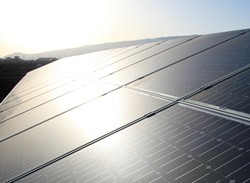 The Renewable Energy Foundation has revealed in a new report that the cost to customers of subsidising solar energy has increased four fold in just two years with further increases expected.
The Renewable Energy Foundation has revealed in a new report that the cost to customers of subsidising solar energy has increased four fold in just two years with further increases expected.
According to the report the Feed In Tariff subsidy that is sourced from energy bills has been used to pay £580m towards the installation of domestic solar panels and to fund larger scale solar farms.
In 2012 this figure was £150m and is expected to surge to £700m by 2015.
Whilst subsidies are rarely appealing to anyone other than the recipient the end product of this initiative is an increase from 2.8 GW of solar generation today to 5 GW in 2015, at which point the subsidies will be reduced.
That increased deployment of solar generation capability is unsurprising given two key elements.
One, the over inflated initial payment regime which at points was awarding customers 10x the prevailing wholesale market price of electricity for each kW produced.
Secondly, that the scheme is due to wind down shortly causing a rush for the final pickings.
John Constable, Director of the REF, said:
“The total annual cost of subsidising solar has gone from zero to about £600 million in four years, largely due to the extremely generous £400MW/h subsidies to domestic rooftop solar offered when the feed-in tariff scheme started.
“By comparison, onshore wind only got £50MW/h at that time. Even after recent cuts, subsidies to new installations of small-scale rooftop solar are still about twice as costly per unit generated as those to onshore wind.”
Although the subsidies have been reduced from the high of £400/MWH to £60/MWH the take up is such that the cost of supporting the Feed In Tariff is booming.
The National Audit Office have warned that the newly awarded Contracts for Difference for large scale green subsidies for five offshore wind farms and three biomass plants will place further strain on energy bills even with the scaling back of the Feed In Tariff.
Indeed the NAO has criticised the latest subsidy awards as “unnecessarily generous” and cautioned that by promising a large element of the overall subsidy budget at this early stage has potentially led to uneconomic agreements with the likes of DONG and Drax under the £16.6bn scheme.
Although not on the 10x scale of the early FIT scheme, the recipients will receive between two and three times the prevailing wholesale market price of electricity for their efforts, an amount that has been subject to intense questioning.
Tom Greatrex, the shadow energy minister, said:
“Consumers will be rightly outraged if they are left to foot the bill for this Tory-led government’s incompetence.”
The Public Accounts Committee has also waded into the debate on subsidy with claims that bill payers will need to pay a minimum of £250bn over the coming 15 years in order to build a fit for purpose energy infrastructure in the UK.
Margaret Hodge, The Public Accounts Committee chairman said:
“It is the consumer – through their various bills – that is expected to fund at least two thirds of this investment where the infrastructure is financed, built, owned and operated by private companies.
“No one in Government is taking responsibility for assessing the overall impact of this investment on consumer bills and whether consumers will be able to afford to pay.
“No one seems to be sticking up for the consumer in all this. This is of particular concern given that the poorest households are hit hardest by increases in bills”.
DECC countered the criticism by justifying the Government’s record on spending and having reversed a policy of underinvestment from previous regimes by saying:
“We have put reforms in place to drive up the £100 billion of private sector investment in electricity between now and 2020 with £45 billion invested already.
“If we do not take action now we are at risk of becoming over-reliant on expensive imported gas and demand for electricity could double by 2050.”
Subsidies carry a crucial role in enabling the renewal of the energy industry, is it too much to expect for them to be well thought through and fit for purpose. Judging by the reactions of the NAO, opposition bench and Public Accounts Committee it would appears so but what is the alternative? Doing nothing is no longer an option.
